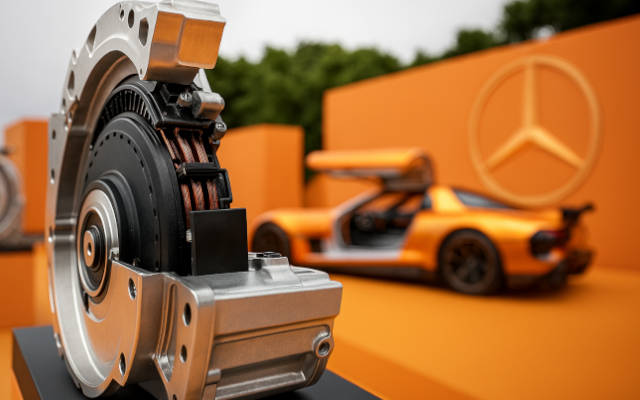Mercedes-AMG's Axial Flux Revolution: Real Tech, Not Clickbait

Mercedes Benz adopts 'game-change' YASA axial flux motor for future EVs
By EVWorld Si Editorial Team
Forget the Hype - Here's the Real Story Behind Mercedes-AMG's Axial Flux Motors
While YouTube headlines scream “bombshell” and “game-changer,” the truth is far more interesting - and far more grounded in engineering. Mercedes-AMG's axial flux motors, developed by UK-based YASA (acquired by Mercedes-Benz in 2021), represent a genuine leap in electric propulsion. But they're not new, and they're not mysterious. They're just better.
How Axial Flux Motors Work - and Why They Matter
Most EVs use radial flux motors, where magnetic flux flows perpendicular to the axis of rotation. These motors are cylindrical, reliable, and well-understood - but they're bulky and limited in power density.
Axial flux motors flip the geometry. Magnetic flux flows parallel to the axis, using disc-shaped rotors and a central stator. This design allows for:
- Higher torque density due to larger rotor diameter
- Smaller, lighter packaging—up to 50% less volume and weight
- Superior thermal efficiency with direct oil cooling
- Reduced material use and simplified manufacturing
YASA’s motors also feature a yokeless segmented armature and flat wire windings, maximizing copper fill and minimizing losses. The result: motors that deliver up to four times the torque density of conventional EV motors and sustain high output without thermal fade.
Deployment Strategy: Centralized Power, Not Wheel Motors
Despite their compact size, Mercedes-AMG is not using axial flux motors as in-wheel motors. Instead, they’re deployed in centralized High Performance Electric Drive Units (HP.EDUs). The AMG GT XX concept, for example, uses:
- Two axial flux motors at the rear, integrated into a single HP.EDU with planetary gearsets and oil-cooled inverters
- One axial flux motor at the front, acting as a boost drive with a spur-gear transmission
This tri-motor layout enables torque vectoring, ultra-fast acceleration, and sustained high-speed performance. The front motor can decouple during coasting to reduce drag and improve efficiency.
Why Internal Combustion Can’t Compete
Compared to ICE engines, axial flux motors offer:
- Instant torque from zero RPM
- Over 90% energy efficiency vs ~30% for ICE
- Fewer moving parts and lower maintenance
- Compact packaging that frees up space for batteries or cabin
Mercedes-AMG’s GT XX concept recently broke 25 EV performance records at Italy’s Nardo Ring, proving that axial flux motors aren’t just theoretical—they’re track-tested and production-ready.
Competing Axial Flux Technologies: Magnax and Lucchi R.E.M.
While YASA leads the charge in automotive axial flux motors, other innovators are pushing the envelope:
Magnax (Belgium)
Magnax develops yokeless axial flux motors with up to 98% efficiency and extremely high power density. Their motors are designed for scalability across electric vehicles, aerospace, and industrial applications. The company’s proprietary winding and cooling techniques reduce manufacturing complexity and material use, making them ideal for high-performance and lightweight platforms.
Lucchi R.E.M. (Italy)
Lucchi specializes in custom axial flux motors with modular, stackable designs. Their motors feature flat copper windings, liquid cooling, and frameless configurations for integration into diverse mechanical systems. Lucchi’s architecture allows for redundancy and overload resilience, making them attractive for commercial and industrial EVs.
Mercedes-Benz’s Future Deployment Strategy
Mercedes-AMG plans to begin series production in 2026 using axial flux motors developed by YASA. The first vehicle to feature this technology will be the AMG GT XX, built on the new AMG.EA platform. This concept uses three axial flux motors—two at the rear in a High Performance Electric Drive Unit (HP.EDU) and one at the front for boost and regeneration.
Beyond the GT XX, Mercedes is expected to deploy axial flux motors in:
- Next-gen AMG CLA 45 (500+ hp EV)
- High-performance variants of the GLC, C-Class, and future M3/X3 rivals
- Motorsport and track-focused EVs with tri-motor torque vectoring setups
These motors are manufactured in-house at Mercedes’ Berlin facility and paired with advanced 800V battery systems capable of 850 kW fast charging. The axial flux architecture enables compact packaging, sustained output, and thermal stability—key for performance EVs that demand consistency under load.
Conclusion: Engineering Over Hype
Axial flux motors are not a “bombshell”—they’re the result of years of research, refinement, and real-world testing. Mercedes-AMG’s deployment strategy favors centralized, high-efficiency drive units over wheel motors, and the results speak for themselves. With production models expected by 2026, this isn’t the future—it’s the present, and it’s built on solid engineering.
Original Backlink
Views: 203
Articles featured here are generated by supervised Synthetic Intelligence (AKA "Artificial Intelligence").
